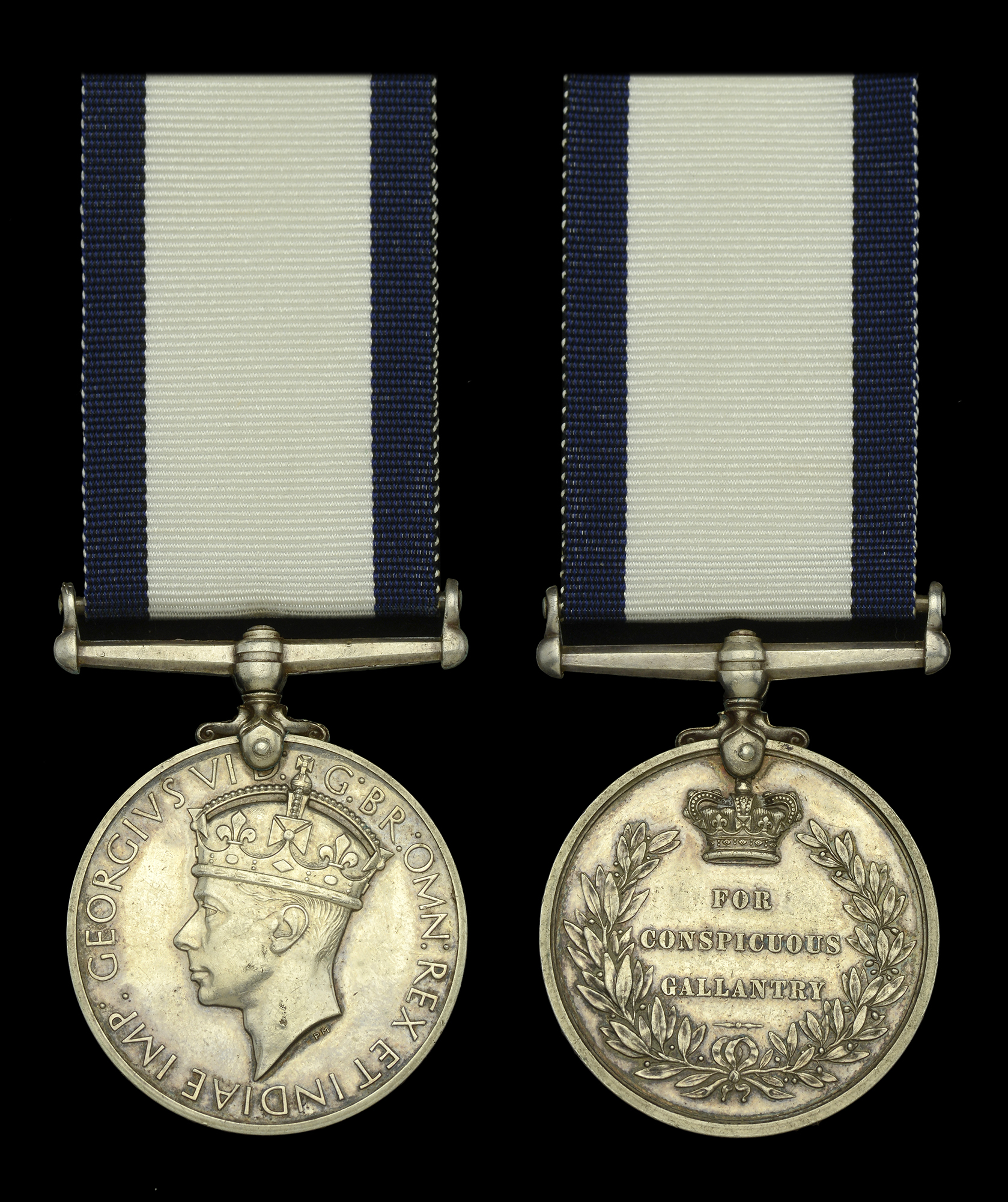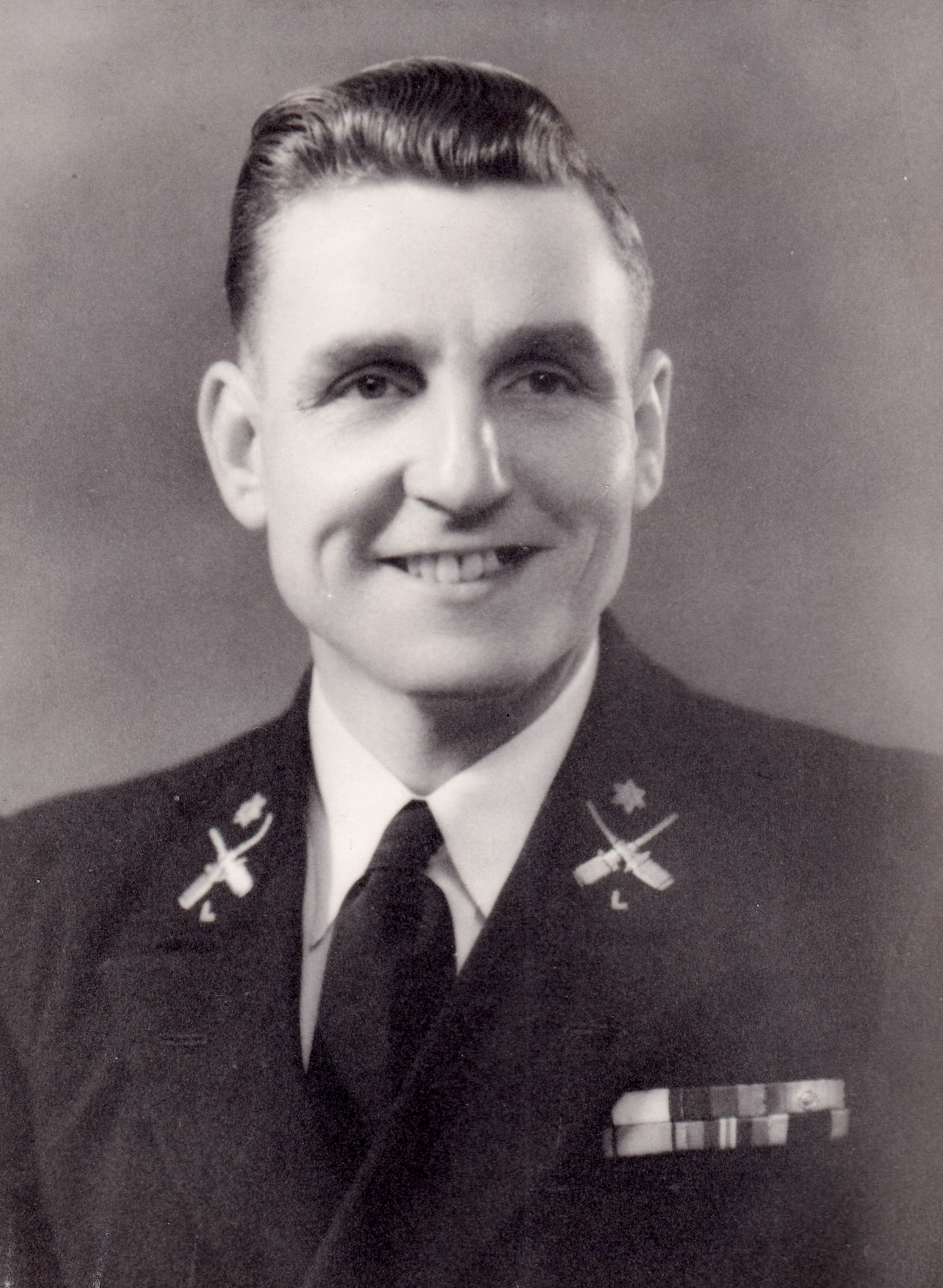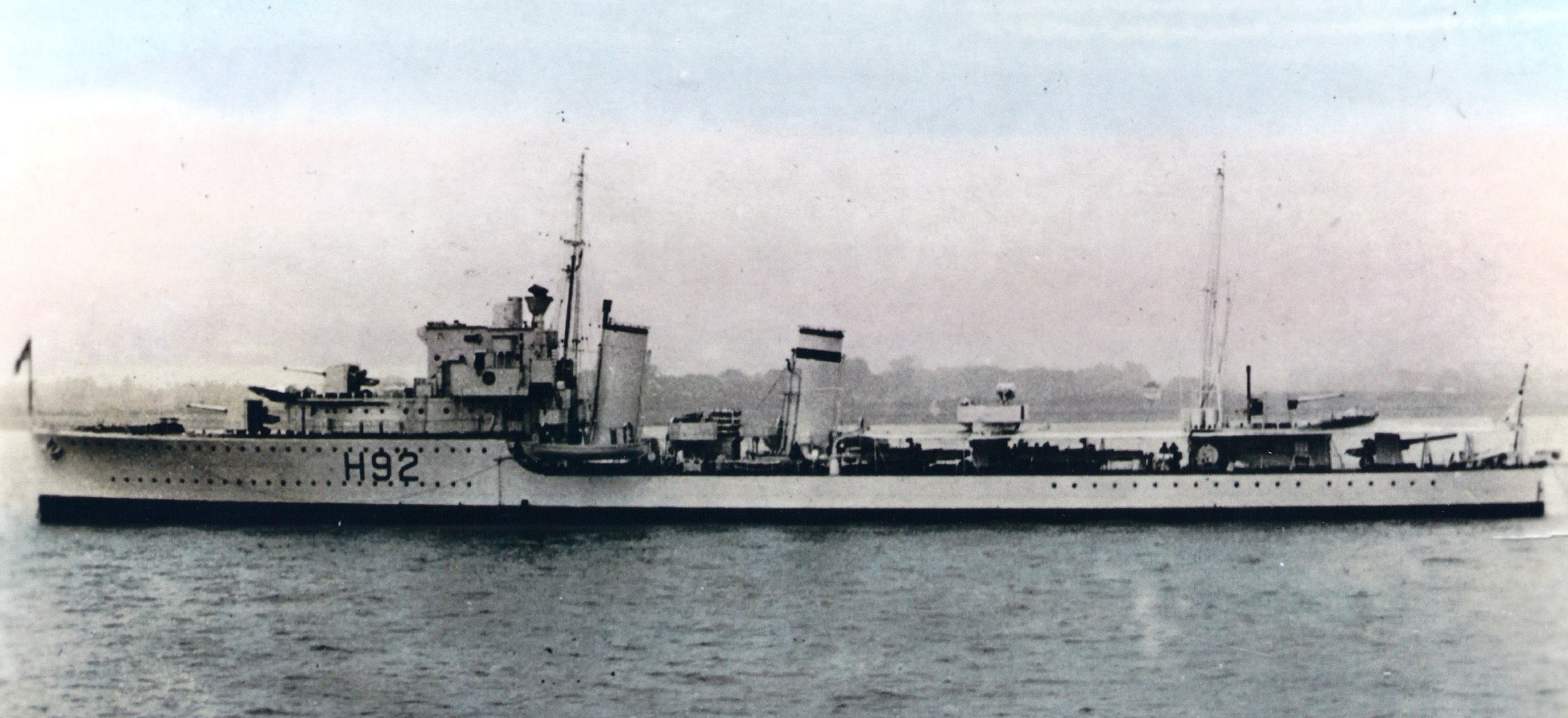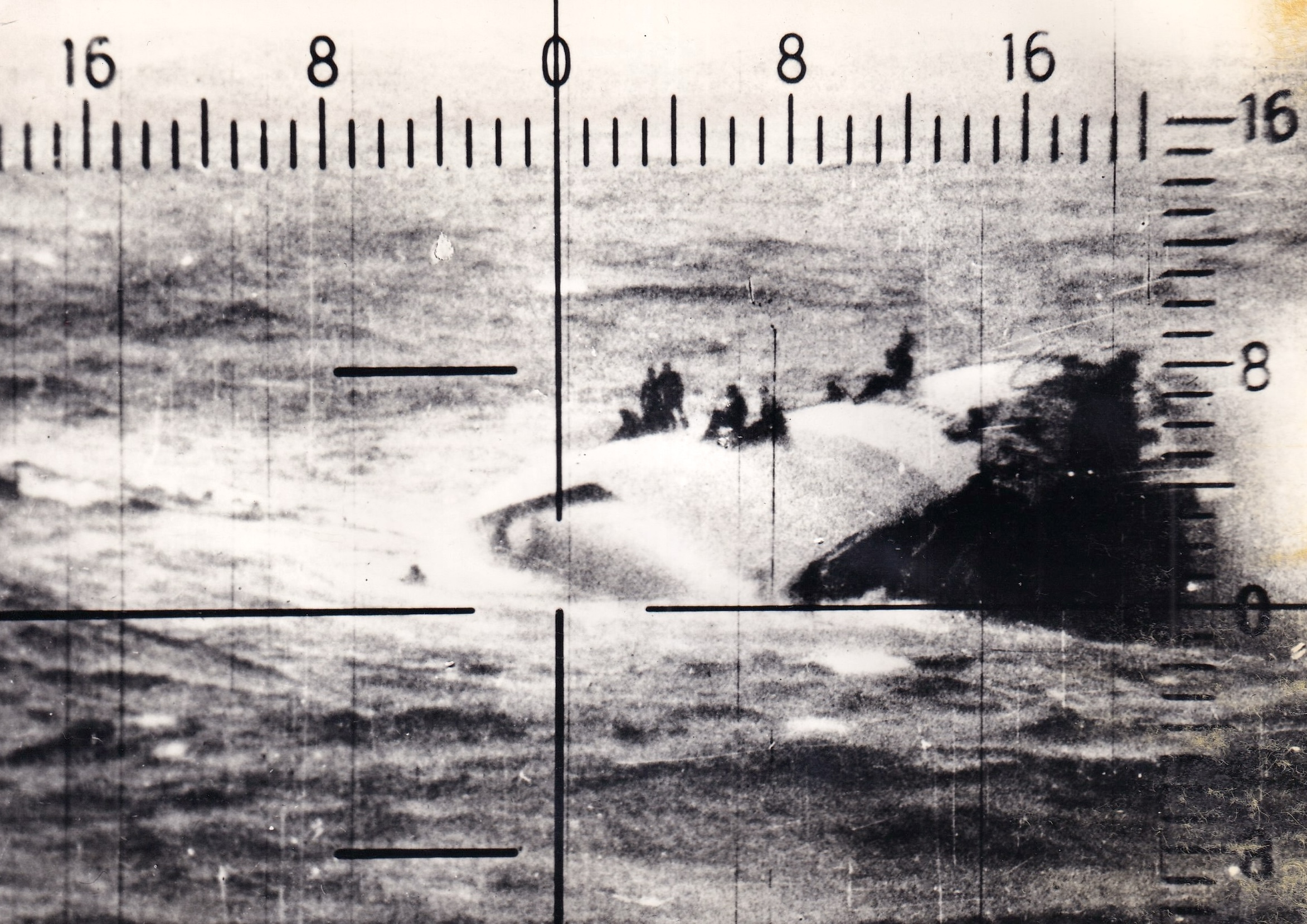The highly emotive Norway 1940 ‘V.C. action’ C.G.M. awarded to Petty Officer W. T. W. Scott, Royal Navy, whose guns were seen to re-engage the enemy after his destroyer H.M.S. Glowworm rammed the heavy cruiser Admiral Hipper, and was sinking: he was one of a handful of survivors from this magnificent but hopeless duel against overwhelming odds Conspicuous Gallantry Medal, G.VI.R., 1st type (P.O. W. T. W. Scott, P/J. 113793) officially engraved naming, good very fine £18,000-£22,000 --- Importation Duty This lot is subject to importation duty of 5% on the hammer price unless exported outside the UK --- --- Provenance: Douglas-Morris Collection, Dix Noonan Webb, February 1997 and July 2003. C.G.M. London Gazette 10 July 1945: ‘For great gallantry in H.M.S. Glowworm’s last action on 8 April 1940. H.M.S. Glowworm attacked the German heavy cruiser Admiral Hipper and, after inflicting damage, was sunk with colours flying.’ In the original Admiralty letter of notification for the recipient’s award, dated 18 July 1945, which is included with the Lot, it is stated that Scott was to be decorated ‘for great bravery in charge of two of the guns of H.M.S. Glowworm during a very gallant action fought on 8 April 1940 against overwhelming odds. After your ship had rammed the enemy and was about to sink from the damage she had received in the action, your guns re-opened fire and scored a hit at close range.’ Churchill’s conjecture that the Glowworm had been sunk by greatly superior forces was an accurate one, but it would be another five years before returning P.O.Ws could reveal the full story of her momentous duel with the Admiral Hipper, an engagement which resulted in a posthumous V.C. to her Captain, Lieutenant-Commander G. B. Roope, R.N. In April 1940, the British War Cabinet, pressed by the French, had resolved to mine Norwegian waters around Narvik, in order to stem the flow of Swedish iron ore to Germany. And the British Expeditionary Force, originally intended for service in the Finnish Winter War, was rapidly recalled and placed on standby in the event of Nazi intervention. In the event, the mining operation, which had been due to commence on the 5th, was delayed until the 8th, due to the French backing out of an agreement to launch some mines on the Rhine in exchange. As it transpired, this was a vital delay. On 7 April the battle cruiser Renown, steaming northwards in the Norwegian Sea to take part in the mining operation, received a signal from one of her four escorting destroyers, the Glowworm, reporting a man overboard and requesting permission to turn back and carry out a search. Given the affirmative, the Glowworm scoured the area for two hours but in vain, and her Captain, Lieutenant-Commander G. B. Roope, R.N., called the search off. That night, as the weather deteriorated, Glowworm was forced to reduce speed, falling yet further behind the Renown and her consorts. Shortly after daybreak on the 8th, Roope sighted a destroyer to the north which at first identified herself as Swedish, but which was in fact the German Paul Jakobi. Without further ado, the latter opened fire. Glowworm responded in kind, with 12 salvoes from her 4.7-inch guns, before switching her attention to another German destroyer, the Bernd von Arnim, which was crammed full of enemy troops for the invasion of Trondheim. Roope decided to shadow her to see whether she would lead him to intelligence of any enemy capital ships. Thus far, the Glowworm was in relatively good shape, although her gun control tower had been flooded by the heavy seas and another two crew members swept overboard. Seven others, too, had been injured by the destroyer’s violent rolling. A short while into her shadowing of the Bernd von Arnim, about five miles to the northwest of her earlier contacts, the Glowworm came upon the 10,000-ton heavy cruiser Admiral Hipper, armed with eight 8-inch and twelve 4-inch guns. The latter was also crammed with enemy troops destined for Trondheim. And Roope had barely got away his enemy sighting report before the Admiral Hipper’s very first salvo found its mark. Although facing impossible odds, he now swung his 1345-ton destroyer onto course for a torpedo attack, under cover of smoke, but had barely uttered the the words of command when another enemy shell found its mark, killing or wounding the Surgeon’s sick bay party. Another shell brought down part of the foremast and wireless aerials, which fouled the steam siren on the funnel, so that Glowworm embarked on her final journey accompanied by the sounds of a strange, tortured wail. Inevitably, perhaps, her spread of her five torpedoes failed to stop the Admiral Hipper, none of them finding their mark. Meanwhile, another direct hit had started a large fire in the engine room, but the gallant Roope ordered a second torpedo attack, emerging from smoke to cross the enemy’s bow from port to starboard, a scene captured by a camera aboard the heavy cruiser. Again, however, the strike failed, and Roope now ordered a sharp turn to starboard to ram the enemy, an objective achieved at 20 knots, the impact resulting in 100 feet of armoured plating being torn from the Admiral Hipper’s starboard side. But no vital damage had been inflicted on the enemy, and, as Glowworm drew away, she was swept by fire from smaller weapons at point-blank range. It was at this juncture, when Glowworm had drifted to a range of about 400 yards, that Petty Officer Scott and his surviving gun crew got away a final salvo that found its mark. At 10 a.m. Roope gave the order to abandon ship but remained on the bridge himself, smoking a cigarette. Later, however, some survivors saw him assist others into their lifejackets, and again, in the water, alongside the Admiral Hipper, but by then too weak to take a rope. According to John Winton’s The Victoria Cross at Sea: ‘Gerard Roope was a large, burly man, with a broad face, firm jaw and forthright manner. He was a career naval officer, devoted to the Service. His ship’s company called him ‘Old Ardover’, for his habit of altering course violently towards his objective whether or not it was the men’s mealtime or any other consideration. It was typical of him to go straight for Hipper ...’ The chivalrous enemy commander, Captain Helmuth Heye, actually stayed for over an hour to pick up survivors, eventually rescuing one Officer and 30 ratings out of Glowworm’s original complement of 149 men. Unlike two of the Glowworm’s survivors who died in captivity, Petty Officer Walter Thomas William Scott was repatriated from Marlag und Milag Nord, Westertimke (Tarnstedt) in 1945, and received his C.G.M. from the hands of the King at an investiture on 30 October 1945. Sold with original Admiralty letter of notification for the award of the C.G.M., dated 18 July 1945.















